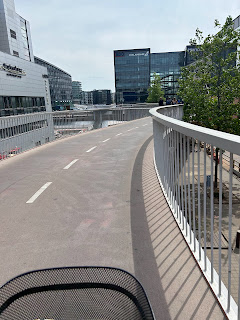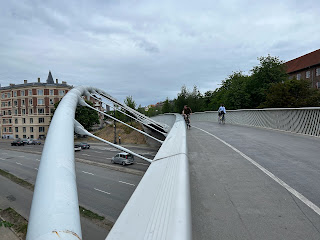Some of the interesting infrastructure I was able to find in Copenhagen:
Bridges
All of the bridges in the city work to connect the islands of Copenhagen together, and some, like the Bicycle Snake, are for bike traffic only. These provide access to the entire city so that it's easy to get places on a bike and so that cyclists don't have to take longer detours to get where they need to go. They aren't simply functional either; some, like the Norrebro park bridge, have aesthetically pleasing designs as well.
Bicycle snake bridge (top) & Norrebro Park bridge (bottom)
Smoothed Cobblestone
Smoothed cobblestone is used here to make it easier for bikes to pass through cobblestone sectors, so it's not incredibly bumpy for bicyclists, but it is still effective in forcing cars to slow down. This can usually be found as ramps so that it's easy to get onto raised cobblestone, as well as smoothed paths on the sides so bikes can easily get past. If a cobblestone section is not smoothed, it's probably because people are not supposed to be biking there and it is a way to divert them to a different route.
An example of smoothed cobblestone for easy bike access
Traffic Calming
One of the methods of traffic calming that is pretty common in Copenhagen is expanding the corners of streets in intersections to a 90 degree angle to both provide more space for the businesses and residents on the street and to slow traffic at the intersection to keep more vulnerable people (cyclists, pedestrians, etc.) safe. Other methods of traffic calming include getting rid of parking, narrowing the roads, and diverting through traffic away from residential roads.
An example of a corner expansion that is now used for trees and plants
Continuous Sidewalks
Continuous sidewalks help drivers to understand that the driveways and roads are crossing the sidewalk (not that the sidewalks are crossing the roads), which guides their driving so that they treat pedestrians with more care. Most of these continuous sidewalks also stay at the same height, so that drivers have to go over a bump instead of pedestrians stepping down to cross a crosswalk, which reinforces this idea. Pedestrians always have the right of way here, but if their sidewalks end or are interrupted with a step down to a crosswalk, its easier for drivers to ignore that fact.
An example of a crosswalk that is continuous in color and pattern across a road
Bike Parking
The bike parking here is generally abundant, but even in places without enough bike parking, you are allowed to park your bikes against buildings and there aren't signs saying "no bike parking" or people there to remove your bike. This makes it super easy to just stop by somewhere and park your bike quickly to run into a store without worrying about breaking the rules.
An example of bike parking and overflow
4 Types of Bike Infrastructure
Shared space
Shared space with cars and bikes
Shared space is where there is either no painted bike infrastructure or there is a sharrow. Shared space seems to generally work well here in Copenhagen, but I think that's because they have instilled a culture of most drivers treating cyclists with respect in protected lanes through laws and infrastructure, so it is carried over to shared space. This is not helpful for cyclists to be able to commute places easily or safely, and it doesn't work as well in American cities as it does here.
Painted lanes
A painted bike lane
Painted lanes are a step safer than sharing space, but in most places they don't provide that much more safety. Here, I feel the same riding somewhere sharing space as in a painted lane, which is safer than riding in my home town, but not as safe as in the elevated cycle tracks.
Grade-separated cycle tracks
An elevated cycle track
The elevated cycle tracks are very effective in keeping cyclists safe and are pretty connected throughout all of Copenhagen; there will most likely be one on the route to any location. These provide good separation from the cars and allow the bikes to be separated from pedestrians as well. At first, I didn't like the grade change, but because there are spots with asphalt ramps in most places that people commonly get off, it's not that bad. However, sometimes when you want to stop its harder to go over a curb to get to bike parking.
A little bit of asphalt right where you need it to get off of the cycle track
Buffered bike lanes
A buffered cycle track, with parking as a buffer between bikes and moving cars
Overall, buffered or not, the elevated cycle tracks feel very safe to bike on compared to the bike lanes (or lack thereof) in American cities. The buffers, whether made of plants, stones, or car parking, provide extra protection that make it so the cars wouldn't be able to hit anyone if they were to even try to get into the bike lanes. These are very effective in creating a safe and connected network of bike infrastructure that takes people where they want to go.
10 Minutes at an Intersection
I spent about 10 minutes observing the behavior of people using all modes of transportation at the intersection of Danasvej and HC Orsteds Vej. At this intersection. there is an expanded corner used as traffic calming, grade-separated cycle tracks that are continued with paint through the intersection, and bike traffic lights, car traffic lights, and pedestrian walk signals for all four ways of traffic.
The Danasvej and HC Orsteds Vej Intersection
Most people using this route seemed like they were on their way home from work, with the occasional independent kids. There was a good amount of traffic for every mode of transportation used; the sidewalks, bike lanes, and busses were all fairly full. The design of the intersection is pretty straightforward for bikes and pedestrians, but it did seem a bit confusing for drivers which led to some breaking of the law. There was a spot through the traffic calming area where they were supposed to turn right with no signage, and there was a large no right turn sign on the traffic light, but I saw a driver miss that first turn and try to turn right, almost running over a cyclist. Thankfully the traffic calming measures forced them to slow down so that no harm was done. Other than that, most people followed the rules and seemed like they were familiar with the intersection, and nobody honked their horn at other cars waiting for cyclists to cross before they did anything.
Other Cool Things on the Bike Infrastructure
A motorized wheelchair user taking advantage of the bike infrastructure
An advertisement on a parked bike
People carrying their children on their bikes
People carrying another bike while on their bike
Reflection
It is very clear how the infrastructure and design of the roads of Copenhagen drive the behavior of the users, whether in a bike, in a car, or on foot. This is an interesting and helpful way to make sure everyone follows the rules and to keep people safe, because not everyone will obey a sign, but if the infrastructure forces them to behave in a certain way, they won't have time to think or read about it.
Despite this, it's important to remember that Copenhagen has good infrastructure, but it's not some bike utopia. Today I was reminded of that when I almost got hit by a large truck. I was cycling in the cycle track, and the truck was supposed to yield at the painted triangles but did not slow down at all. What surprised me most was that even when I swerved out of the way, the driver just kept going. I'm not sure if it was because the truck was so high up that they couldn't see me, or because the painted yield infrastructure was ineffective, or both. I really like what Copenhagen has done with its bike infrastructure, but it's disappointing that it's not a safe haven for all people on bikes and that people might lose their lives as a consequence.
- Lauren















